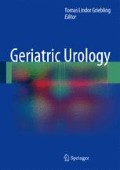Abstract
Urologists, more than ever, are commonly long-term providers of care to their patients over several years, developing meaningful therapeutic relationships. Like many areas of medicine, urology has been successful in curing many of the common acute ailments and now is increasingly faced with managing chronic disease. As part of this aspect of their practice, urologists may find end-of-life care very rewarding. The dying process has become more complex and now takes longer. Patients in the USA now live an average of 30 months after they receive a terminal diagnosis. During those 30 months, patients often receive about 75 % of the health care that they receive during their entire lifetime. This chapter reviews important concepts in palliative and end-of-life care for those who provide urologic care for older adults.
Access this chapter
Tax calculation will be finalised at checkout
Purchases are for personal use only
References
Ambuel B. Giving bad and sad news. In: Weissman DE, Ambuel B, editors. Improving end-of-life care: a resource guide for physician education. Milwaukee, WI: The Medical College of Wisconsin; 1999.
Old JL, Swagerty DL. A practical guide to palliative care. Philadelphia, PA: Lippincott Williams & Wilkins; 2007.
Storey P, Knight CF. Alleviating psychological and spiritual pain in the terminally ill, UNIPAC two. Hospice/Palliative care training for physicians. 2nd ed. Glenview, IL: American Academy of Hospice and Palliative Medicine; 2003. 15.
Joranson DE, Ryan KM, Gilson AM, et al. Trends in medical use and abuse of opioid analgesics. JAMA. 2000;283:1710–4.
Fishman SM. Legal aspects in pain medicine for primary care physicians. Supplement to Family Practice News. New York, NY: Academy for Healthcare Education; 2006. Available at http://www.AHECME.com
WHO Ladder. Cancer pain relief and palliative care. Technical Report Series 804. Geneva: World Health Organization; 1990.
Lutz S, Conner S. Radiation oncology and hospice; cornerstones in palliative care. Am Acad Hosp Palliat Med Bull. 2005;6:1–3.
Tisdale BA. When to consider radiation therapy for your patient. Am Fam Physician. 1999;59:1177–89.
Author information
Authors and Affiliations
Corresponding author
Editor information
Editors and Affiliations
Rights and permissions
Copyright information
© 2014 Springer Science+Business Media New York
About this chapter
Cite this chapter
McDonald, M., Swagerty, D.L. (2014). Palliative Care. In: Griebling, T. (eds) Geriatric Urology. Springer, New York, NY. https://doi.org/10.1007/978-1-4614-9047-0_30
Download citation
DOI: https://doi.org/10.1007/978-1-4614-9047-0_30
Published:
Publisher Name: Springer, New York, NY
Print ISBN: 978-1-4614-9046-3
Online ISBN: 978-1-4614-9047-0
eBook Packages: MedicineMedicine (R0)

